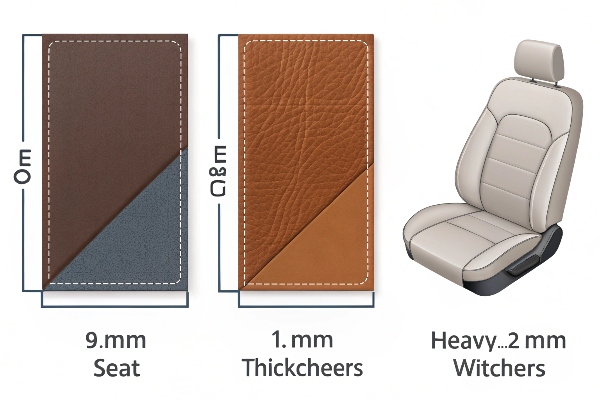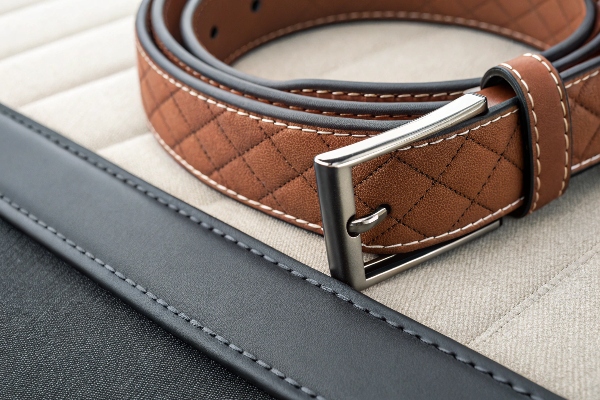I once saw a sofa crack after six months because its PVC layer was too thin—painful proof that thickness matters.
PVC leather for furniture and cars usually ranges from 0.7 mm to 1.6 mm; choose 0.9 mm–1.2 mm for seating softness, 1.2 mm–1.4 mm for wear zones, and 1.4 mm–1.6 mm for heavy-duty panels.

Many buyers skip thickness checks and jump straight to color swatches.
I want to keep you reading because one wrong decimal point can cost thousands—let’s break the choice down step by step and save you that pain.
How to differentiate leather and PVC?
I once mixed up real leather with PVC in a sample room and almost lost a client—don’t repeat my mistake.
Genuine leather shows irregular pores and fibers on the cut edge; PVC shows a smooth, foamy core, smells like plastic, and warms slowly to touch.

Dive deeper
Sight, touch, and smell
| Method | Real Leather | PVC Leather |
|---|---|---|
| Pore pattern | Uneven, natural | Repeating, printed |
| Edge view | Fibrous layers | Sponge-like cell foam |
| Odor | Slight animal smell | Plastic, sometimes sweet |
| Thermal feel | Warms fast on palm | Stays cool longer |
I start with the back side. I bend the sample; real leather wrinkles with tiny color change while PVC keeps a uniform fold line. Then I run my nail on the surface. Real hide shows a fading scratch that recovers; PVC often leaves a bright, permanent line. Finally, I burn a tiny corner with a lighter in a safe test room.
Real leather smells like burning hair, and the ash powders; PVC melts, drips, and smells acidic. These three checks give me 95 % accuracy before any lab test. When I train new staff at WanDao, I make them repeat these steps blindfolded. Within a week they can pick the right sheet every time, saving us lab fees and giving clients quick answers.
What are the disadvantages of PVC leather?
A buyer from a start-up bag brand once asked me, “Is PVC all upside?” I had to give her the full picture.
PVC can turn brittle in cold, emits VOCs during early life, and can discolor under UV; choose additives wisely and confirm standards.

Dive deeper
Key risk areas and fixes
| Issue | Cause | Simple Fix |
|---|---|---|
| Cold crack below ‑10 °C | Rigid plasticizer loss | Ask for cold-resistant plasticizers |
| VOC smell in cabins | High solvent residue | Order low-VOC or water-based coatings |
| Yellowing in sun | Cheap stabilizers | Demand UV-B blockers, test 200 h Q-SUN |
| Delamination | Weak base fabric | Specify ≥300 g/m² polyester or microfiber |
I recall a shipment to Scandinavia that failed at destination because the PVC sheet hit ‑15 °C in transit and cracked during unpacking. We replaced it with a cold-flexible formula that bends at ‑25 °C and refunded the freight—an expensive lesson.
Now I add a “climate tag” to every quotation. If the client’s end market faces extreme cold, I push them to pick low-temperature plasticizers even if cost rises by 0.15 USD/m². For VOCs, I insist on ISO 12219-2 chamber tests.
The report reassures car assemblers and keeps me off recall lists. Yes, PVC has flaws, but a clear spec sheet and lab backup turn most of them into manageable costs rather than surprises.
How can you tell the thickness of leather?
During my first factory tour I saw an operator guess thickness by eye; he was off by 0.3 mm—never trust eyeballing.
Use a calibrated thickness gauge, press with 2 N force for three seconds, and measure at five points; average gives true thickness within ±0.05 mm.

Dive deeper
Step-by-step thickness check
- Condition sample at 23 °C, 50 % RH for 24 h.
- Zero the micrometer at 0.00 mm.
- Place anvils on flat area away from emboss lines.
- Apply 2 N pressure, hold three seconds.
- Record center, four corners.
| Position | Reading 1 | Reading 2 |
|---|---|---|
| Center | 1.18 mm | 1.20 mm |
| Corner A | 1.16 mm | 1.17 mm |
| Corner B | 1.19 mm | 1.18 mm |
| Corner C | 1.17 mm | 1.19 mm |
| Corner D | 1.16 mm | 1.18 mm |
| Average | 1.17 mm | 1.18 mm |
I keep two gauges: a bench-top dial for lab reports and a pocket digital for showroom visits. They cost less than a single defective roll, yet many buyers skip them. I also photograph the gauge reading alongside the roll code and email it to clients before shipping. This habit built trust and ended disputes. Remember, emboss height can trick the gauge; always cut a flat piece if the grain is deep. When numbers back your choice, your spec sheet protects you from surprises on the production line.
What is PVC thickening leather?
A new client once asked for “thickening leather” without knowing what that means.
PVC thickening leather adds extra foam or backing layers to reach 2.0 mm–3.0 mm, giving padded feel for belts, armrests, or luxury cases.

Dive deeper
Construction and uses
| Layer | Material | Function |
|---|---|---|
| Surface coat | PU-modified PVC | Scratch, color |
| Foam | Soft PVC micro-cell | Cushion |
| Reinforce | Woven or non-woven | Tear strength |
| Back cloth | Brushed fabric | Glue bonding |
These layers are laminated in one pass or multilayer calendering. I choose foam density between 0.25–0.35 g/cm³ for belts so they flex yet stay firm. For gaming chairs I move to 0.18 g/cm³ for a softer hand.
Thickening leather saves time in upholstery because the padding is already built in; the worker skips extra foam sheets. But beware: cutting thick PVC needs sharp knives or laser to avoid frayed edges.
I advise clients to slow blade speed by 30 % and raise tool temperature slightly. When we switched a Turkish bag maker to 2.5 mm thickening leather, they cut assembly time by 12 % and reported a sturdier feel that let them raise retail price by 10 %. Right thickness is not just numbers—it is profit hidden in millimeters.
Conclusion
Choose PVC thickness with data, test tools, and climate in mind; the right millimeter saves money, boosts quality, and keeps customers smiling.
